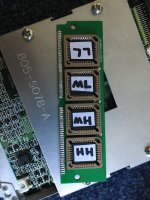So I'm trying to figure out what's going on with my IIx, When turned on it it chimes and immediately gives chimes of death. According to apple's troubleshooting guide this is a ram issue
What I have done so far is:
Recapped the board
Try with known good ram (Both in all 8 slots and only in bank A, and both 256K sticks and 1M sticks)
Replaced all 8 ram slots (They all had broken clips so needed replacing anyway)
Checked continuity of all 32 data lines from the CPU to the ram slots (As well as the GLU, NuBus, VIA 1, VIA 2, SCC, SCSI chips and the 74 series logic chips by NuBus slot 1 where applicable)
Checked the continuity of all 32 address lines from the CPU to the 74 series logic below the RAM slots (As well as the GLU, NuBus, VIA 1, VIA 2, SCC, SCSI chips and the 74 series logic chips by NuBus slot 1 where applicable)
Checked the continuity of all the address lines from 74 series logic below the RAM slots to the ram slots (through the appropriate resistors which are all the correct value)
Checked the continuity of all the pins of the ram slots to the appropriate pins of the other ram slots (One break was found and repaired, which has not fixed the problem)
Measured all the data lines with the oscilloscope, all had activity (Some had more than others, but none where stuck high or low)
Measured RAS, CAS and R/W with the oscilloscope which all lock fine (Activity on RAS and CAS, R/W is high which I believe is correct as it Mac isn't writing anything to the RAM)
Measured all the address lines with the oscilloscope this is where I am a little unsure, some show activity and some don't, some will show no activity but will if you reset the mac and some only show activity when the mac initially powers on
I have also spent a long time looking over the board for bad traces or via's and there are plenty that look terrible (The board had minor battery leakage), but all that I have tested still have continuity
I'm now not sure where to go from here, really expecting to have a broken trace due to the battery damage but I can't seem to find one
And advice would be appreciated!
What I have done so far is:
Recapped the board
Try with known good ram (Both in all 8 slots and only in bank A, and both 256K sticks and 1M sticks)
Replaced all 8 ram slots (They all had broken clips so needed replacing anyway)
Checked continuity of all 32 data lines from the CPU to the ram slots (As well as the GLU, NuBus, VIA 1, VIA 2, SCC, SCSI chips and the 74 series logic chips by NuBus slot 1 where applicable)
Checked the continuity of all 32 address lines from the CPU to the 74 series logic below the RAM slots (As well as the GLU, NuBus, VIA 1, VIA 2, SCC, SCSI chips and the 74 series logic chips by NuBus slot 1 where applicable)
Checked the continuity of all the address lines from 74 series logic below the RAM slots to the ram slots (through the appropriate resistors which are all the correct value)
Checked the continuity of all the pins of the ram slots to the appropriate pins of the other ram slots (One break was found and repaired, which has not fixed the problem)
Measured all the data lines with the oscilloscope, all had activity (Some had more than others, but none where stuck high or low)
Measured RAS, CAS and R/W with the oscilloscope which all lock fine (Activity on RAS and CAS, R/W is high which I believe is correct as it Mac isn't writing anything to the RAM)
Measured all the address lines with the oscilloscope this is where I am a little unsure, some show activity and some don't, some will show no activity but will if you reset the mac and some only show activity when the mac initially powers on
I have also spent a long time looking over the board for bad traces or via's and there are plenty that look terrible (The board had minor battery leakage), but all that I have tested still have continuity
I'm now not sure where to go from here, really expecting to have a broken trace due to the battery damage but I can't seem to find one
And advice would be appreciated!


